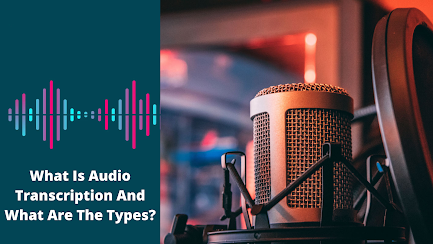What Is Audio Transcription And What Are The Types?
The potential applications of audio transcription are rapidly expanding thanks to machine learning. However, in order to make the best use of this increasingly important service, you must first understand what it involves. There are numerous Audio Data Transcription, each with its own set of advantages and disadvantages. It goes without saying that the type of audio transcription you select can have a significant impact on your project. What exactly does your company require? A priority for any aspiring entrepreneur should be defining exactly what things your company can’t live without, let alone thrive without. You must provide everything from project management platforms and collaborative tools to meeting rooms and internal communications for your team in order to keep things running smoothly.
Audio transcription is a necessary part of many businesses’ daily operations. There has been a significant shift in content from written to audio and video, which means that an audio transcription service will need to type up reams of data. Recording audio has also become much easier; recording interviews, meetings, and seminars is not a common practice in many industries. But what happens when we press the “stop recording” button? Most businesses fail to realise the full value of their recorded content, and some leave the spoken word on audio files without transcribing it- but is this an effective way to ensure your business thrives?
What is audio transcription?
The process of converting speech in an audio file into written text is known as audio transcription. That could be any audio recording, such as an interview, academic research, a video of your great-grandmother’s speech at her birthday party, or a company town hall meeting.
What are the types of Audio Transcription?
There are many types of audio transcription, these are:
- Verbatim Transcription: This is one of the most detailed types of transcription available. It is also known as true verbatim or strict verbatim transcription. It aims to capture all filler words, pauses, and nonverbal communication contained in the recording, as well as all of the speaker’s words. As a result, verbatim transcripts are typically lengthy and highly detailed. If there are multiple speakers on the audio, verbatim transcribers may also notice interruptions, conversational affirmations such as “right” or “uh-huh”, and overlapping conversation. All words and nonverbal communication, such as laughter, pauses, and coughing, are included. Ambient background noise, such as talking or audience noise, may also be included. Noises irrelevant to the transcript or that may interfere unnecessarily with the flow of reading, such as police sirens, thunder, or construction work, are not included.
- Edited Transcription: Edited transcription, also known as clean verbatim transcription, is frequently used by transcription services. It is committed to preserving the meaning of a text, just like verbatim transcription. A well-edited transcription will not paraphrase or change the meaning of the text in any way. It does not, however, aim to capture the speaker’s communication style. Stammering, filler, words like “like” or “you know”, and unnecessary nonverbal communication are typically avoided. This is due to the fact that they add little to the meaning of the text. The goal of edited transcription, on the other hand, is to strike a balance between completeness and readability.
- Included: All crucial text said by the speaker.
- Not included: Ambient Noise, sounds, and non-verbal communication. Filler words or phrases which don’t alter meanings are also eliminated. For audio with numerous speakers, interruptions and affirmations may also be removed.
- Intelligent Transcription: Sometimes referred to as intelligent verbatim transcription, this service is mostly focused on transcribing audio into compact, legible sentences. Transcribers have far more freedom to change and eliminate sections of speech than in the previous transcription types. Intelligent transcription strives to transmit the meaning of the speech in the most natural way possible, rather than holding simply to the speech as it was uttered. This can include removing repetitive sentences and phrases, as well as grammatically recognising what was spoken.
- Included is a version of the tape that stresses clear communication of what was said. Punctuation and grammar problems will be rectified as needed.
- What’s not included: in addition to removing noise and nonverbal communication, the final result will be free of all filler words, repeats, and off-topic content. The transcript may not match the audio exactly in the terms of speech stated, but it should capture the meaning of what was said.
- Phonetic Transcription: A phonetic transcription is a specific form of transcription which differs greatly from the other types of audio transcription discussed above. It seeks to capture the way speakers utter sounds, with a special emphasis on word pronunciation. This can also extend to the annotation of the way that the speaker’s tone rises and falls, as well as how distinct sounds overlap within the audio.
- Included: A complete catalogue of all the sounds uttered by speakers in the audio type in the phonetic alphabet. Further comments detailing the speaker’s intonation may also be supplied. It’s worth checking to see if your phonetics will include a more formal transcript.
- Noises that may interfere with the transcription are not included.
GTS and Audio transcription
AI Data Collection and annotation services are provided by Global Technology Solutions. Image data gathering, speech data collection, video data collection, and text data collection are among the services we provide. We have the necessary skills and resources to finish the work.

Comments
Post a Comment